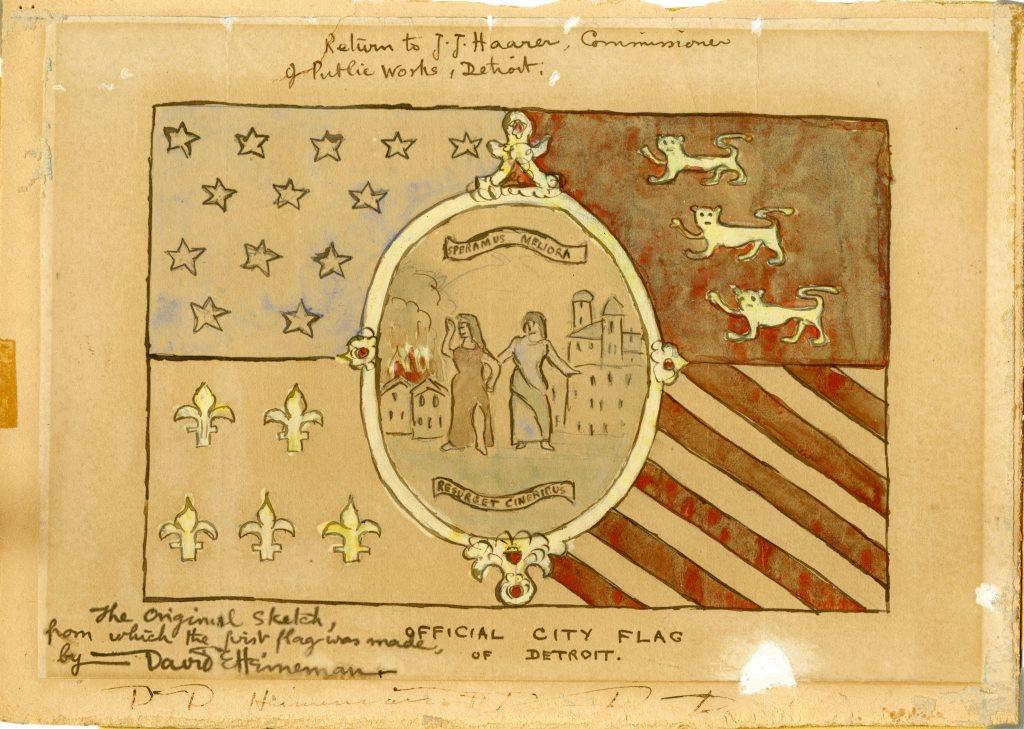Detroit’s seldom-seen official flag seems to have gained more traction recently. Once almost completely relegated to government buildings, it now can be spotted on stickers, draped on the backs of attendees at outdoor festivals, and in miniature form at the Detroit Historical Museum gift shop. This gradual warming toward the flag mirrors its history. Detroit was without a flag for 206 years, and after David Emil Heineman finally remedied this in 1907, it took the city another forty-one years to adopt it officially.
David Emil Heineman was the son of Jewish-German immigrant, Emil Solomon Heineman, who ran a clothing store within Detroit’s Russell House on Campus Martius. David Emil Heineman ventured deep into law and politics, serving as a state legislator, president of the city’s Common Council, City Controller, and Assistant City Attorney. He was also a scholar, having written the book “Jewish Beginnings in Michigan Before 1850.” Heineman’s foray into design was reported inspired while marching in the 1906 Memorial Day parade when he decided that City Hall looked too “squatty” without flags hanging from its corners. Soon after, he set out to design a flag that would flatter City Hall. At the center of Heineman’s design was an oval-shaped field containing an image of the city seal—itself designed by artist J.O. Lewis in 1827—representing the 1805 fire, and subsequent rebuilding. The seal also owes part of its lineage to Father Gabriel Richard, who, following the fire, wrote the included Latin motto, “speramus meliora; resurget cineribus,” or “we hope for better things; it will rise from the ashes”. Heineman surrounded the seal with four fields representing the kingdoms and nations which have claimed the city during its history. The white field of five fleurs-de-lis at the lower left represents France under the House of Bourbon, which held Detroit from 1701 to 1760. The red field containing three lions passant at the upper right represents Great Britain, who held the city from 1760 to 1796, and again during the War of 1812 from 1812 to 1813. The blue field of stars at the upper left, and stripes at the lower right represent the United States, which aside from the brief interruption during the War of 1812, has held the city since 1796. Heineman sketched his design and submitted to the Commissioner of Public Works. The flag was made in time for Pennant Day on June 12, 1908, a day on which the pennant won by the Detroit Baseball Club was displayed alongside city flags. Although the flag saw continual official use following this initial outing, it was not officially adopted until 1948 when Mayor Eugene Van Antwerp realized the oversight after receiving a request for an official flag from an Eastern advertising firm.
 This needlepoint interpretation of the flag of the city of Detroit was made in 1976, by Helen Coutts, a retired English teacher from Redford High School and a member of the Detroit Historical Society Guild.
This needlepoint interpretation of the flag of the city of Detroit was made in 1976, by Helen Coutts, a retired English teacher from Redford High School and a member of the Detroit Historical Society Guild.
While Heineman’s design has persisted, it has been slightly tweaked over the years. The most obvious change is perhaps the circular seal replacing the old oval-shaped one. In 1976 in order to accommodate modern printing techniques, the number of colors in the flag were streamlined and codified according to the Pantone system by the Detroit Historical Commission and the Public Information Department. While the Detroit flag may lack the visibility of the, Tigers’ Old English ‘D’ which has transcended baseball to serve as a de facto pop culture symbol for the city, it does encapsulate the city’s history, and echo the ever-present theme of rebirth in the city’s story better than any single letter could. How do you feel about the city’s flag? How would you have designed it?
